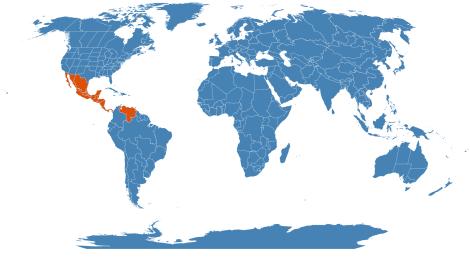Accession Data
Plumeria rubra
Common Name: Frangipani
Family: Apocynaceae
Country of Origin: Mexico to Venezuela
Description: Tree, to 25 feet; leaves broadly elliptic to obovate or oblong-lanceolate, to 20 inches long, obtuse to acuminate, with prominent marginal connecting vein, glabrous to densely pubescent beneath, petioles to 4.5 inches long; inflorescence rather open; corolla salverform, to 4.5 inches across, white with yellow center to various shades of rose and yellow, tube to 1 inch olng; follicles to 1 foot long.
Extrafloral nectaries in base of petiole, flower bud.
In mature trees, the large apex and leaves typical of the seedlings get smaller with each branching of the axis, a phenomenon called apoxogenesis.
Native from Mexico to Panama but widely cultivated in warm areas and in greenhouses.
Uses: Traditional Medicine: All parts of this plant are used in traditional medicine to treat a wide range of maladies including: Decoction of bark is used as purgative, emmenagogue, and febrifuge. Latex is similarly employed. Preventive for heat stroke: the material may be taken as a cooling tea. Root-bark taken internally as a strong purgative. Root-bark used as abortifacient. Root bark used as remedy for gonorrhea and venereal sores. Bark decoction used as antiherpetic. In India, bark used as purgative. Bark also used as application for abscesses. In Java and Madera, bark decoction used for gonorrhea, dropsy, and dysuria due to venereal disease. In Yucatan, latex is used for toothache. In Persia, bark is employed against blenorrhagia. For dysentery, diarrhea during summer season: use 12 to 24 gms of dried material in decoction. To treat arthritis, rheumatism, pruritic skin lesions mix the latex (sap) with coconut oil, warm, and apply to affected area. A decoction of the bark is used as a counterirritant on the gums for toothache. The latex mixed with coconut oil is used for itching. The juice is rubefacient in rheumatic pains, and with camphor, is also used for itching. A poultice of heated leaves is beneficial for swellings. Decoction of leaves for cracks and eruptions of the soles of the feet. Infusion or extract from leaves is used for asthma. Leaves also used as cigarettes to inhale in asthma. In Puerto Rico, in emulsion, the milk produces abundant, bilious, watery stools. In Mexico,a decoction of flowers used in diabetes.
Scientific studies have verified the following activity: • Cytotoxic, Antitumor, Antibacterial, Molluscicidal, Essential Oils, Pytochemical, Antimicrobial, Antioxidant, Hypolipidemic, Anti-Inflammatory, Free Radical Scavenging Activity, Antimutagenic.
Info from Philippine Alternative Medicine; http://www.stuartxchange.org/Kalachuchi.html
Accession Data
USDA Zone: 9b-11
Accession #: 198500454
Accession Date: 1985-12-31 00:00:00
Bloom Status: 🌸 Flowering
Location: 1215
Quantity: 1
Source: Unknown
Classification
Division: Magnoliophyta
Class: Magnoliopsida
Subclass: euasterid I
Order: Gentianales
Family: Apocynaceae
SubFamily: Rauvolfioideae
Tribe: Plumerieae
Flowering Data:
This accession has been observed in bloom on:| Year | Jan | Feb | Mar | Apr | May | Jun | Jul | Aug | Sep | Oct | Nov | Dec | ||||||||||||||||||||||||||||||||||||||||
|---|---|---|---|---|---|---|---|---|---|---|---|---|---|---|---|---|---|---|---|---|---|---|---|---|---|---|---|---|---|---|---|---|---|---|---|---|---|---|---|---|---|---|---|---|---|---|---|---|---|---|---|---|
| 2025 | ||||||||||||||||||||||||||||||||||||||||||||||||||||
| 2024 | ||||||||||||||||||||||||||||||||||||||||||||||||||||
| 2023 | ||||||||||||||||||||||||||||||||||||||||||||||||||||
| 2022 | ||||||||||||||||||||||||||||||||||||||||||||||||||||
| 2021 | ||||||||||||||||||||||||||||||||||||||||||||||||||||
| 2020 | ||||||||||||||||||||||||||||||||||||||||||||||||||||
| 2019 | ||||||||||||||||||||||||||||||||||||||||||||||||||||
| 2018 | ||||||||||||||||||||||||||||||||||||||||||||||||||||
| 2017 | ||||||||||||||||||||||||||||||||||||||||||||||||||||
| 2016 | ||||||||||||||||||||||||||||||||||||||||||||||||||||
| 2015 | ||||||||||||||||||||||||||||||||||||||||||||||||||||
| 2014 | ||||||||||||||||||||||||||||||||||||||||||||||||||||
| 2013 | ||||||||||||||||||||||||||||||||||||||||||||||||||||
| 2012 | ||||||||||||||||||||||||||||||||||||||||||||||||||||
| 2011 | ||||||||||||||||||||||||||||||||||||||||||||||||||||
| 2010 | ||||||||||||||||||||||||||||||||||||||||||||||||||||
References
- The Plant List (2013). Version 1.1. Last accessed on Thursday, August 31, 2017.
- WCSP (2016). World Checklist of Selected Plant Families. Facilitated by the Royal Botanic Gardens, Kew. Last accessed on Thursday, August 31, 2017.
- Hortus Third, LH Bailey Hortorium, 1976
- The Plant Book, DJ Mabberly, 1987
Images

